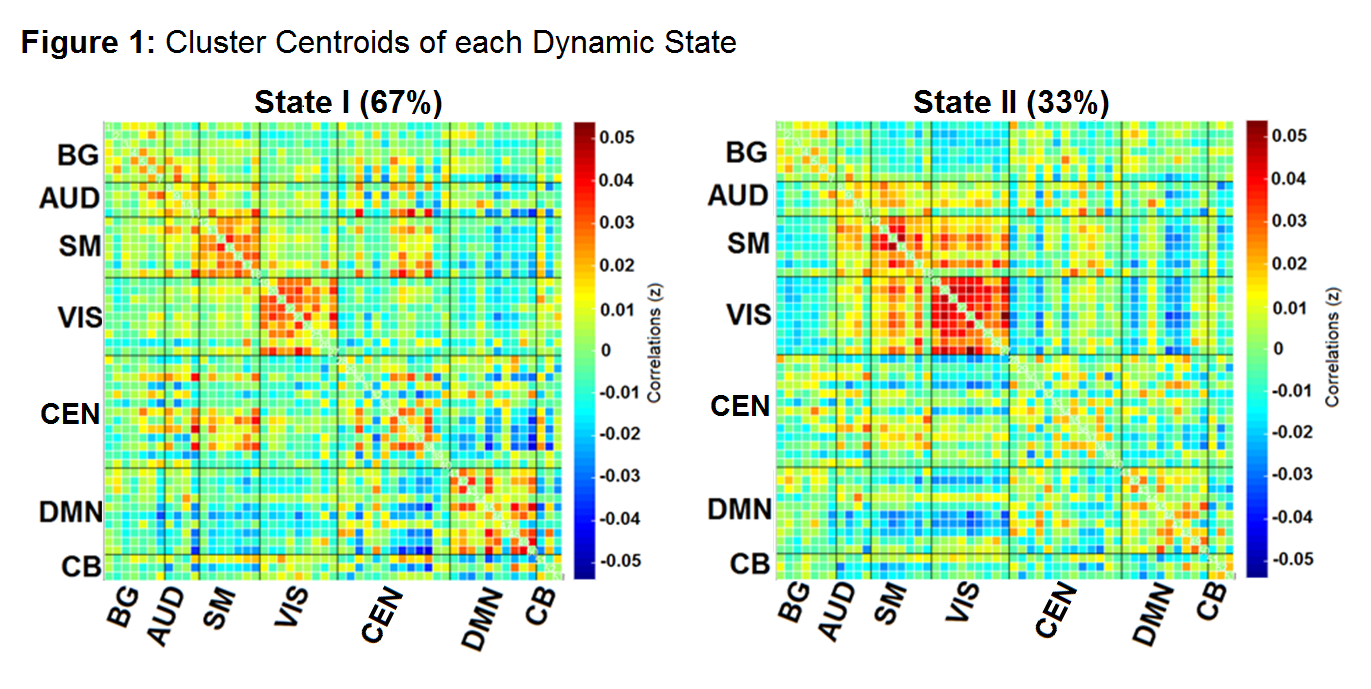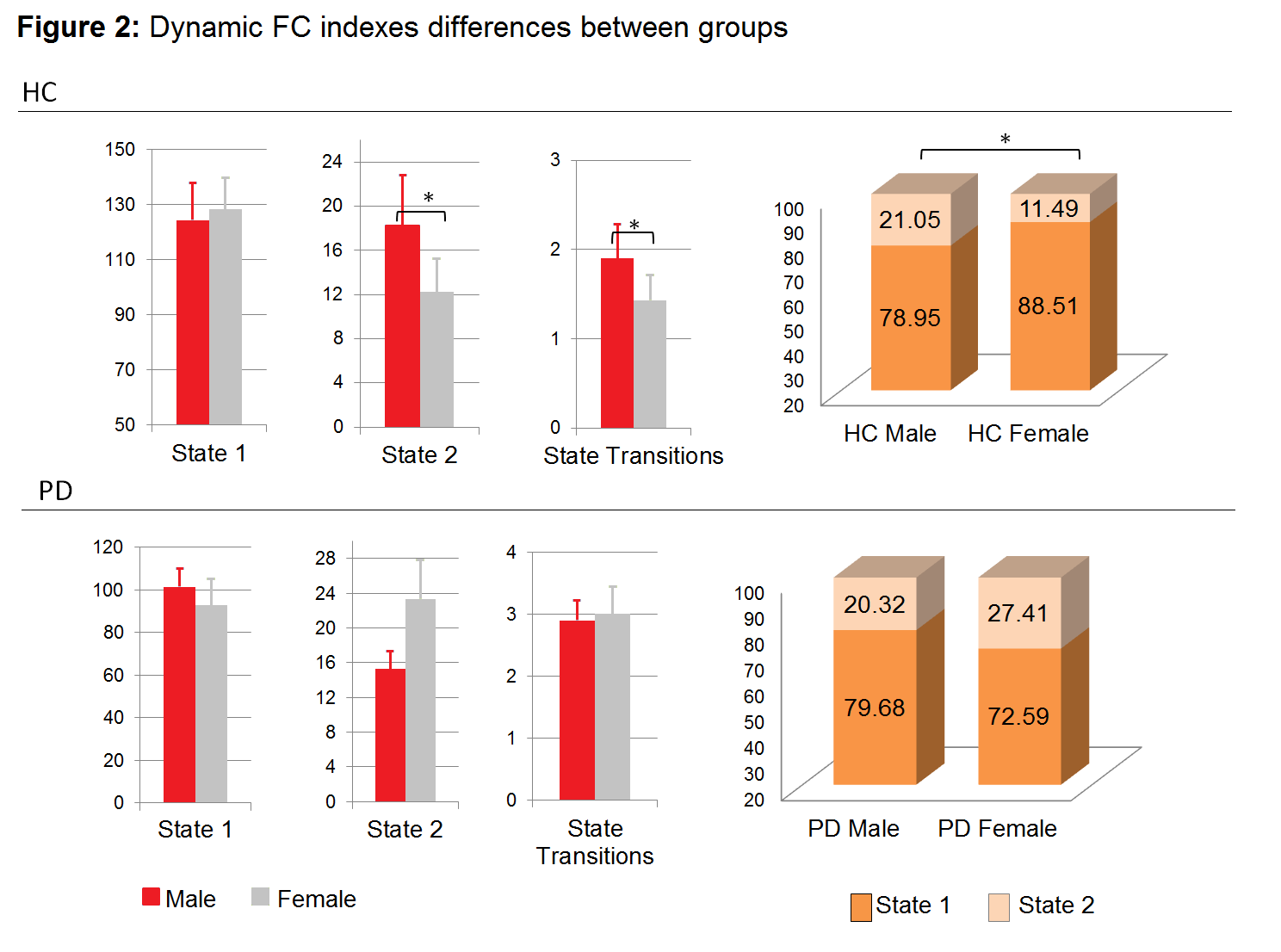Category: Parkinson's Disease: Neuroimaging
Objective: The main objective was to evaluate the influence of sex in time-varying functional connectivity (FC) characteristics in Parkinson’s disease (PD) patients and healthy adults (HC).
Background: Sex differences were found to have an impact on static brain FC in HC, mostly in the default-mode network (DMN) and somatomotor (SM) networks [1-4]. However, to date, little is known about the influence of sex on brain FC in PD patients.
Method: One-hundred and eight PD patients and 63 HC underwent a neuropsychological and clinical assessment. Resting-state fMRI and T1-weighted MRI were also acquired. Independent Component Analysis was performed and the selected 53 components were classified according to the following networks: Basal Ganglia, Auditory (AUD), SM, Visual (VIS), Central-Executive (CEN), DMN and Cerebellar networks. Dynamic FC analyses were performed in GIFT toolbox. The temporal properties of dynamic FC were analyzed: Fractional time window, Mean dwell time, and State transitions. Multivariate analyses of covariance were performed to test differences between groups, with education, depression, acquisition site and total brain volume as covariates.
Results: Dynamic FC analyses identified two dynamic FC States: State I, characterized by within-network positive coupling (mostly within DMN, CEN, VIS networks); and State II that showed between-network connectivity, mostly between SM and VIS networks (Figure 1). Sex differences were found in dynamic indexes in HC (Figure 2). HC females showed increased Fractional time window in the within-network connected state (State I). On the contrary, HC males showed increased Mean dwell time in the between-network connected state (State II) that was accompanied by increased State transitions. No significant differences were found when comparing male and female PD patients (Figure 2).
Conclusion: Findings revealed sex differences in dynamic connectivity patterns in HC that were not detected in patients with PD. Sex differences in the HC group were in line with previous findings in static FC. The absence of sex differences among PD patients in dynamic FC patterns might be related to disease pathology and progression, which may overcome the effect of sex in brain dynamics in PD.
References: 1-Biswal BB, Mennes M, Zuo XN, Gohel S, Kelly C, Smith SM, et al. Toward discovery science of human brain function. Proc Natl Acad Sci U S A 2010; 107: 4734-9. 2-Allen EA, Erhardt EB, Damaraju E, Gruner W, Segall JM, Silva RF, et al. A baseline for the multivariate comparison of resting-state networks. Frontiers in systems neuroscience 2011; 5. 3-Ritchie SJ, Cox SR, Shen X, Lombardo MV, Reus LM, Alloza C, et al. Sex differences in the adult human brain: evidence from 5216 UK Biobank participants. Cerebral Cortex 2018; 28: 2959-75. 4-Zhang C, Dougherty CC, Baum SA, White T, Michael AM. Functional connectivity predicts gender: evidence for gender differences in resting brain connectivity. Hum Brain Mapp 2018; 39: 1765-76.
To cite this abstract in AMA style:
M. Diez-Cirarda, I. Gabilondo, N. Ibarretxe-Bilbao, J.C Gomez-Esteban, J. Kim, O. Lucas-Jimenez, R. Del Pino, J. Peña, N. Ojeda, A. Mihaescu, M. Valli, M.A Acera, A. Cabrera, M.A Gomez-Beldarrain, A.P Strafella. Sex differences on dynamic functional connectivity in Parkinson’s disease and healthy controls [abstract]. Mov Disord. 2020; 35 (suppl 1). https://www.mdsabstracts.org/abstract/sex-differences-on-dynamic-functional-connectivity-in-parkinsons-disease-and-healthy-controls/. Accessed October 17, 2025.« Back to MDS Virtual Congress 2020
MDS Abstracts - https://www.mdsabstracts.org/abstract/sex-differences-on-dynamic-functional-connectivity-in-parkinsons-disease-and-healthy-controls/


